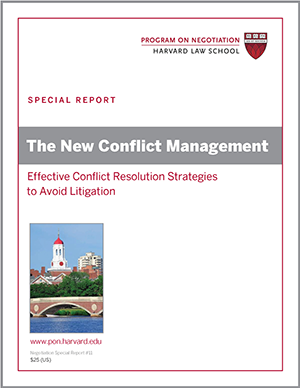
Using conflict resolution techniques, the city of Los Angeles recently achieved an impressive victory by ending a 100-year battle with California’s Owens Valley over water rights and air pollution.
The dispute dates back to the early 1900s, when agents working for the city of Los Angeles, posing as farmers and ranchers, bought up most of the Owens Valley in an attempt to quench the water needs of their booming city, writes Adam Nagourney in an account of the dispute and conflict resolution for the New York Times. In 1913, Los Angeles began diverting water from the Owens River, about 200 miles to the north, into the city via aqueducts. The intrigue surrounding the city’s ethically questionable maneuvers provided the storyline of the legendary 1974 Jack Nicholson film “Chinatown.”
By 1923, Owens Lake, which had spanned about 100 square miles and was fed by the Owens River fed, dried up. The resulting dry lake bed became the single largest source of dust pollution in the United States. The thick haze at times shrouded the entire Owens Valley has long been blamed for high asthma rates among local residents.
Predictably, a difficult debate over who bore responsibility for clearing the dust sprang up. Several factors made the dispute particularly intractable:
Competing standards. Over the course of the dispute, the city of Los Angeles continually downplayed the degree to which the lake bed was to blame for the dust problem. The Great Basin Unified Air Pollution Control District, advocating for the Owens Valley region, used dust-measuring devices to push Los Angeles to accept responsibility for cleaning up the area. The city responded with lawsuits. When parties cite differing “objective” standards to support their arguments, impasse is likely.
A culture clash. The fact that the dispute pitted a major metropolis against a three-county area populated by only about 31,000 people exacerbated the dispute. “We are very different people,” one Owens Valley resident told the Times. Tension and distrust built up to the point that William W. Funderburk, a lawyer representing Los Angeles, compared the dispute to the ongoing Israeli-Palestinian conflict. “Bad blood had just been passed on through the generations,” he said. This type of us-versus-them mentality leads negotiators to demonize the other side to the point that agreement seems impossible.
The passage of time. As any experienced negotiator knows, the longer a dispute lasts, the harder it becomes to resolve. As a conflict passes from one generation to the next, it hardens into an intractable dispute, as happened in the Owens Valley.
When a conflict is deeply entrenched, a new mentality is often required to help parties view it in a fresh way and move beyond their antagonism. The following steps lead to a breakthrough in the California feud:
Mounting expenses. Financial and other practical incentives sometimes motivate parties to move beyond their hardline positions. To try to reduce the dust, Los Angeles had been pouring 25 billion gallons of water per year—almost as much as the city of San Francisco consumes annually—on the lake bed. The waste became increasingly costly and difficult to justify in light of California’s ongoing drought. In addition, Los Angeles was losing its expensive legal fights against the Great Basin. When Los Angeles mayor Eric M. Garcetti was elected in 2013, he told his new appointees to replace the dispute-focused approach with negotiation.
Deference and contrition. Launching new negotiations aimed at ending the dispute once and for all, the city of Los Angeles struck a more conciliatory tone. Mayor Garcetti publicly apologized for the city’s role in the feud, and Los Angeles delegates to a new round of negotiations made an effort to show deference and better understand the Great Basin district’s concerns. When parties stop arguing and start listening, they often can build trust, even with longtime opponents.
Thinking outside the box. A new spirit of collaborative problem solving between the Los Angeles Department of Water and Power and the Great Basin district led to a successful conflict resolution. Instead of flooding the entire lake bed, the parties realized that they could till part of it—about 50 square miles—to create furrows that could be sprinkled with a modest amount of water. The tilling, which has begun, is expected to drastically reduce water waste while addressing the pollution problem.
By recognizing that their combative approach had failed, the parties appear to have reached a mutually satisfying solution through proven conflict-resolution techniques.
In 1997, Los Angeles signed an agreement with the basin to clean up the air pollution—a move that opened up a dispute about the degree to which the lake bed was responsible for the dust.
Related Article: Top 10 Business Deals of 2013





Interesting overview, with one small missing piece: the parties attempted to negotiate a resolution in 2010-11 but the “timing” proved to be premature for the type of discussions required to make progress. At this point the litigation strategy referenced in your note apparently was endorsed by decision makers, and that’s where resources were committed. Sometimes testing BATNAs is part of the process.